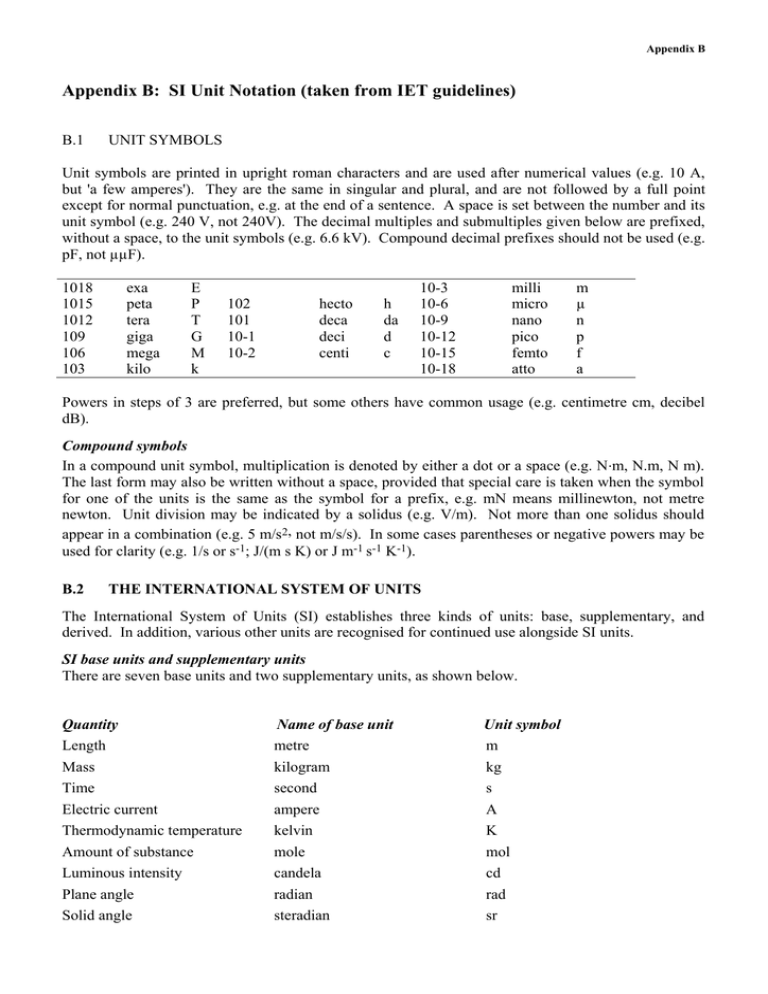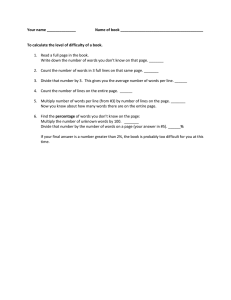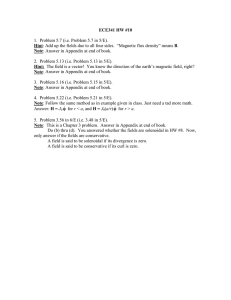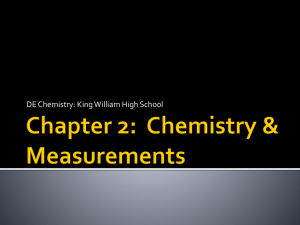Appendix B: SI Unit Notation (taken from IET guidelines)
advertisement

Appendix B Appendix B: SI Unit Notation (taken from IET guidelines) B.1 UNIT SYMBOLS Unit symbols are printed in upright roman characters and are used after numerical values (e.g. 10 A, but 'a few amperes'). They are the same in singular and plural, and are not followed by a full point except for normal punctuation, e.g. at the end of a sentence. A space is set between the number and its unit symbol (e.g. 240 V, not 240V). The decimal multiples and submultiples given below are prefixed, without a space, to the unit symbols (e.g. 6.6 kV). Compound decimal prefixes should not be used (e.g. pF, not µµF). 1018 1015 1012 109 106 103 exa peta tera giga mega kilo E P T G M k 102 101 10-1 10-2 hecto deca deci centi h da d c 10-3 10-6 10-9 10-12 10-15 10-18 milli micro nano pico femto atto m µ n p f a Powers in steps of 3 are preferred, but some others have common usage (e.g. centimetre cm, decibel dB). Compound symbols In a compound unit symbol, multiplication is denoted by either a dot or a space (e.g. N.m, N.m, N m). The last form may also be written without a space, provided that special care is taken when the symbol for one of the units is the same as the symbol for a prefix, e.g. mN means millinewton, not metre newton. Unit division may be indicated by a solidus (e.g. V/m). Not more than one solidus should appear in a combination (e.g. 5 m/s2, not m/s/s). In some cases parentheses or negative powers may be used for clarity (e.g. 1/s or s-1; J/(m s K) or J m-1 s-1 K-1). B.2 THE INTERNATIONAL SYSTEM OF UNITS The International System of Units (SI) establishes three kinds of units: base, supplementary, and derived. In addition, various other units are recognised for continued use alongside SI units. SI base units and supplementary units There are seven base units and two supplementary units, as shown below. Quantity Length Name of base unit metre Unit symbol m Mass Time Electric current Thermodynamic temperature Amount of substance Luminous intensity Plane angle Solid angle kilogram second ampere kelvin mole candela radian steradian kg s A K mol cd rad sr Appendix B The definitions of these units are as follows: metre (m): The metre is the length of the path travelled in vacuum by light during (1/299 792458) second. kilogram (kg): The mass of the international prototype of the kilogram. second (s): The duration of 9 192 631 770 periods of the radiation corresponding to the transition between the two hyperfine levels of the ground state of the caesium 133 atom. ampere (A): That constant current which, if maintained in two straight parallel conductors of infinite length, of negligible circular cross-section, and placed 1 metre apart in vacuum, would produce between these conductors a force equal to 2 x 10-7 newton per metre of length. kelvin (K): The unit of thermodynamic temperature is the fraction 1/273.16 of the thermodynamic temperature of the triple point of water (but see footnote)* candela (cd): The luminous intensity, in a given direction, of a source which emits monochromatic rays with a frequency 540 x 1012 hertz and whose energy intensity in that direction is (1/683) watt per steradian. mole (mol): The amount of substance of a system which contains as many elementary entities as there are atoms in 0.012 kilogram of carbon 12. When the mole is used, the elementary entities must be specified and may be atoms, molecules, ions, electrons, other particles, or specified groups of such particles. radian (rad): The plane angle between two radii of a circle which cut off on the circumference an arc equal in length to the radius. steradian (sr): The solid angle which, having its apex at the centre of a sphere, cuts off an area of the surface of the sphere equal to that of a square with sides of length equal to the radius of the sphere. The supplementary units 'radian' and 'steradian' are to be regarded as dimensionless derived units which may be used or omitted in the expressions for derived units. * In addition to the thermodynamic temperature (symbol T), expressed in kelvins, use is also made of Celsius temperature (symbol t) defined by the equation t = T –T0, where T0= 273.15 K by definition. The unit 'degree Celsius' is equal to the unit 'kelvin', but 'degree Celsius' is a special name in place of 'kelvin' for expressing Celsius temperature. A temperature interval or a Celsius temperature difference can be expressed in degrees Celsius as well as kelvins but kelvins is to be preferred. Appendix B SI derived units The units of all physical quantities are derived from the base an supplementary SI units, and certain of them have been named. These, together with some common compound units, are given here: Quantity Unit name SI Units Unit symbol Force Energy Power Pressure, stress Electrical potential Electric charge, electric flux Magnetic flux Magnetic flux density Resistance Conductance Capacitance Inductance Celsius temperature newton joule watt pascal volt coulomb weber tesla ohm siemens farad henry degree celsius kg m/s2 Nm J/s N/m2 J/C, W/A As Vs Wb/m2 V/A A/V C/V Wb/A K N J W Pa V C Wb T Frequency Luminous flux Illuminance Activity (radiation) Absorbed dose Dose equivalent hertz lumen lux becquerel gray sievert s-1 cd sr lm/m2 s-1 J/kg J/kg Hz 1m lx Bq Gy Sv Mass density Torque Electric field strength Magnetic field strength Thermal conductivity Luminance kilogram per cubic metre newton metre volt per metre ampere per metre watt per metre candela per square metre S F H oC kg/m3 Nm V/m A/m Wm-1 cd/m2 Appendix B Non-SI units Some commonly used units not within the SI range are: degree (1o = /180 rad); minute 1' = (1/60)o); second (1" = (1/60)'); revolution (1 r = 2 rad) Energy calorie (cal); electronvolt(eV); watt-hour (W h) Length ångström (Å) Mass ton (ton); tonne (=metric ton) (t); unified atomic mass mass unit (u) Pressure, stress atmosphere (atm); bar (bar); torr (Torr) Rotational frequency revolution per minute (r/min)*, revolution per second (r/s)* Time minute (min; hour (h); day (d); year (a) Volume litre (L, 1 or litre) Angle * These are widely used for rotational frequency in specifications of rotating machinery B.3 QUANTITY SYMBOLS FOR ELECTROTECHNICS Quantity Admittance Attenuation Attenuation coefficient Bandwidth Capacitance Charge Charge density, surface volume Symbol Y A Conductance Conductance, mutual Conductivity Control angle, rectifier inverter Coupling factor G gm k SI unit S Np† dB† m–1 Hz F C C/m2 C/m3 S S S/m rad rad - Current Current density, area linear Current linkage Damping coefficient Decrement, logarithmic Dipole moment electric magnetic Dissipation factor I J A A A/m2 A/m p j d A s-1 Cm Wb m - B C Q Appendix B Distortion factor Electric (space) constant Electric field strength level Electric flux Electric flux density Electric polarisation Electric susceptibility Electromotive force Energy Energy, Fermi Feedback factor Frequency Frequency, angular deviation complex angular Gain Group velocity Group delay Hall coefficient Impedance Impedance characteristic surge Inductance, self mutual Leakage factor Loss angle Magnetic (space) constant Magnetic field strength Magnetic flux density linkage Magnetic (area) moment Magnetic polarisation Magnetic susceptibility Magnetic vector potential Magnetisation Magnetomotive force Mobility d 0 E LE D P , e , e E E,We F ß f G cg,v g tg R H, A H F/m V/m dB† C C/m2 C/m2 V J J‡ Hz rad/s Hz s–1 m/s s m3/C Z Z0 Z0 L Ljk,M d H B m B i, J ,K A H i,M F,ƒm H H rad H/m A/m Wb T Wb, wB-t† A m2 T Wb/m A/m A m2V–1s–1 Appendix B Modulation factor (a.m) index (f.m.) Noise factor m power temperature Number of density of particles Number of phases Number of pole pairs, pulses Number of turns Period Permeability, absolute relative Permeance Permittivity, absolute relative Phase angle delay Pn Tn deviation Phase change Phase-change coefficient Phase velocity Polarisation, electric magnetic Potential Potential difference Power, active apparent reactive Power factor Power factor, sinusoidal Power-level difference Poynting vector Propagation coefficient Q factor, magnification Radiant energy Radiation resistance Rating Reactance Reflection coefficient Refractive index F, Fn W K m–3 s H/m H, Wb/A F/m rad rad n m p N T µ µr r B P c rad - v P Bi, J V U,V P S Q cos S rad rad rad/m m/s C/m2 T V V W VA var‡ Np,† dB† W/m2 Q Q Q,W Rr J S X r, n V A,W - Appendix B Regulation Reluctance Resistance Resistance-temperature coefficients Resistivity Signal Slip Standing-wave ratio Susceptance Susceptibility, electric magnetic Transconductance Transfer function Transmission factor Turn-, turn-off-off time Voltage R, R m R p.u.† H–1, A/Wb ½ K–1 m , e ,K gm S A/V,S H t on, t off V Wavelength Work function s V m J‡ Unit symbol appropriate to the physical quantity concerned †Not an SI unit but in common use ‡More usually expressed in eV B.4 SUBSCRIPTS AND OTHER USES OF LETTERS AND NUMBERS It is recommended as a guiding principle for the printing of subscripts that, when these are symbols for physical quantities, they should be printed in italic type. Numbers as subscripts should be printed in roman type; numerical variables (e.g. running subscripts) should be printed in italic type. All other subscripts should be printed in roman type. Appendix B Some commonly used abbreviations, often occurring as subscripts, are as follows: General a amb as av b br c ch cp cr d dem absolute acoustic active additional alternating ambient anode anti-resonance axial ambient asynchronous average backward base breakdown calculated carrier case coercive collector correction critical cut-off chemical composite critical d-axis damped delay deviation diameter difference diffuse direct dissipation distortion dynamic demodulation Appendix B e exp f fl effective electric emitter equivalent error external experimental field filament, heater final forward frequency floating g airgap gate grid group h hysteresis height, depth hybrid i im in ind ideal image induced initial input instantaneous intermediate internal intrinsic image insertion indirect j junction k cathode knee iterative short circuit transformation ratio K Appendix B l L m max med min mod leakage limiting line local longitudinal load large signal magnetic magnetising maximum measured mechanical mutual peak value maximum median minimum modulation n natural noise nominal o output spherical characteristic in vacuo open circuit optical original overload oc opt or ov p pd ph pk pt pu p-p parallel, shunt parasitic pole, or pair of poles primary psophometric pulse pull down phase peak punch through pull up peak-to-peak Appendix B q q-axis quadrature quiescent turn off r radial radiation rated real relative reflection remanent residual resonance resulting reverse reverse transfer rotational rotor reference r.m.s. value ref rms s sat sc sim sin stg suc t th secondary segment series signal spherical standardised static stator steady state storage synchronous saturation short circuit simultaneous sinusoidal storage successive tangential total transient transmission transverse thermal Appendix B theoretical total tot u usual useful v luminous varying vacuum valley x reactive crosstalk 0 characteristic free space no load zero frequency 1 full load fundamental input port 1 positive sequence primary 2 negative sequence output port 2 second harmonic secondary 3 tertiary ,p parallel P, n perpendicular 0, s spherical Appendix B at infinity Appendix B Resistor colour codes 1st digit black 0 brown 1 red 2 orange 3 yellow 4 gree n 5 blue 6 violet 7 grey 8 white 9 2n d digit black 0 brown 1 red 2 orange 3 yellow 4 gree n 5 blue 6 violet 7 grey 8 white 9 3rd di gi t black 0 brown 1 red 2 orange 3 yellow 4 gree n 5 blue 6 violet 7 grey 8 white 9 black brown red orange yellow gree n blue violet grey white Mu lti plie r multiply by 1 multiply by 10 multiply by 100 multiply by 1000 multiply by 10000 multiply by 100000 multiply by 1000000 multiply by 10000000 multiply by 100000000 multiply by 1000000000 Tole ran ce brown 1% red 2% gold 5% silver 10% Te mp. coe ffi cie n t black 100 ppm brown 50 ppm red 25 ppm orange 15 ppm yellow 10 ppm gree n 5 ppm blue 1 ppm Capacitor colour codes 1st digit black 0 brown 1 red 2 orange 3 yellow 4 gree n 5 blue 6 violet 7 grey 8 white 9 2n d digit black 0 brown 1 red 2 orange 3 yellow 4 gree n 5 blue 6 violet 7 grey 8 white 9 Mu lti plie r black multiply by 1 brown multiply by 10 red multiply by 100 pF r ange orange multiply by 1000 yellow multiply by 10000 white divide by 10 µF r ange grey divide 100 Tole ran ce white 10% black 20% W ork in g volt age brown 100 V dc red 250 V dc yellow 400 V dc blue 630 V dc S ome standard decade values E24 : 10 11 12 13 15 16 18 20 22 24 27 30 33 36 39 4347 51 56 62 68 75 82 91 E12 : 10 12 15 18 22 27 33 39 47 56 68 82 E6 : 10 15 22 33 47 68


